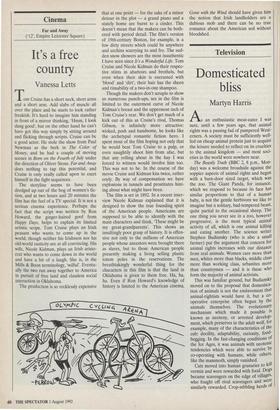Cinema
Far and Away (`12', Empire Leicester Square)
It's a free country
Vanessa Letts
Tom Cruise has a short neck, short arms and a short arse. Add slabs of muscle all over the place and he starts to look rather freakish. It's hard to imagine him standing in front of a mirror thinking, `11mm, I look dang good', but on the other hand he can't have got this way simply by sitting around and flicking through scripts. Cruise can be a good actor. He stole the show from Paul Newman as the perk in The Color of Money, and he had a couple of moving scenes in Born on the Fourth of July under the direction of Oliver Stone. Far and Away does nothing to tap this potential, and Cruise is only really called upon to exert himself in the fight sequences.
The storyline seems to have been dredged up out of the bog of women's fic- tion, and at two hours and 20 minutes the film has the feel of a TV special. It is not a serious cinema experience. Perhaps the fact that the script was written by Ron Howard, the ginger-haired goof from Happy Days, helps to explain its limited artistic scope. Tom Cruise plays an Irish peasant who wants to come up in the world, though neither his Irishness nor his old-world rusticity are at all convincing. His wife, Nicole Kidman, plays an Irish aristo- crat who wants to come down in the world and have a bit of a laugh. She is, in the Mills & Boon terminology, 'wilful'. Eventu- ally the two run away together to America in pursuit of free land and classless social interaction in Oklahoma.
The production is so recklessly expensive that at one point — for the sake of a minor detour in the plot — a grand piano and a stately home are burnt to a cinder. This doesn't mean that the makers can be both- ered with period detail. The film's version of 19th-century Boston, for example, is a few dirty streets which could be anywhere and urchins scurrying to and fro. The sud- den snow showers are the most inauthentic I have seen since It's a Wonderful Life. Tom Cruise and Nicole Kidman do their respec- tive stints in abattoirs and brothels, but even when their skin is encrusted with `blood' and 'dirt', their hair has the sheen and rinsability of a two-in-one shampoo.
Though the makers don't scruple to show us numerous punch-ups, sex in the film is limited to the outermost curve of Nicole Kidman's breast and the uppermost inch of Tom Cruise's rear. We don't get much of a kick out of this as Cruise's rival, Thomas Gibson, is infinitely more attractive: wicked, posh and handsome, he looks like the archetypal romantic fiction hero. I spent most of the film hoping not only that he would beat Tom Cruise to a pulp, or even naughtily shoot him from afar, but that any rolling about in the hay I was forced to witness would involve him too. This was not to be. In the course of the movie Cruise and Kidman kiss twice, rather coyly. By way of compensation we have explosions in tunnels and prostitutes hint- ing about what might have been.
The film is set in 1892. In a recent inter- view Nicole Kidman explained that it is designed to show the true founding spirit of the American people. Americans are supposed to be able to identify with the main characters and think, 'These might be my great-grandparents'. This shows an insultingly poor grasp of history. It is offen- sive not only to the millions of American people whose ancestors were brought there as slaves, but to those American people presently making a living selling plastic totem poles in the reservations. The breathtakingly wonderful thing for the characters in this film is that the land in Oklahoma is given to them free. Ha, ha, ha. Even if Ron Howard's knowledge of history is limited to the American cinema, Gone with the Wind should have given him the notion that Irish landholders are a dubious mob and there can be no true romance about the American soil without bloodshed.


















































 Previous page
Previous page